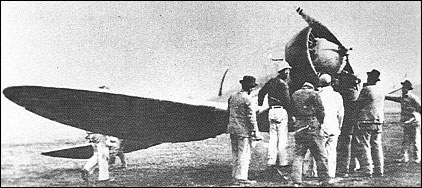|
| Among several 9-Shi requirements, in February 1934, the Imperial Navy issued an outline specification for a single-seat fighter. Carrier compatibility was not demanded. It was assumed that accommodating the dictates of deck use from the outset would inhibit the design team in achieving an advance in the state of the fighter design art. It was, of course, self-evident that the service would have no use for a fighter incapable of shipboard operation. In view of his experience with the earlier 7-Shi fighter, design responsibility was assigned by Mitsubishi to Jiro Horikoshi who created an all-metal semi-monocoque stressed-skin monoplane of inverted gull form designated Ka-14. Powered by a 600hp Nakajima Kotobuki 5 nine-cylinder radial and carrying two 7.7mm guns, the first Ka-14 was flown on 4 February 1935. Latent doubts concerning the wing "gulling" had, meanwhile, led to elimination of this feature from the wing of the second prototype Ka-14, which also embodied split flaps and switched to a 715hp Kotobuki 3 engine. This prototype was to provide the basis for the series production A5M1 (Type 96) fighter, the first Ka-14 being fitted with a close-fitting, long-chord cowling as part of a drag reduction programme.
 | A three-view drawing (1278 x 826) |
| WEIGHTS |
| Take-off weight | 1373 kg | 3027 lb |
| DIMENSIONS |
| Wingspan | 11.00 m | 36 ft 1 in |
| Length | 7.67 m | 25 ft 2 in |
| Height | 3.26 m | 11 ft 8 in |
| Wing area | 16.00 m2 | 172.22 sq ft |
| PERFORMANCE |
| Max. speed | 444 km/h | 276 mph |
| voxan, e-mail, 01.04.2010 06:15 hehehe.. reply |
|
Do you have any comments?
|
| 
COMPANY
PROFILE
All the World's Rotorcraft
|








20
reply